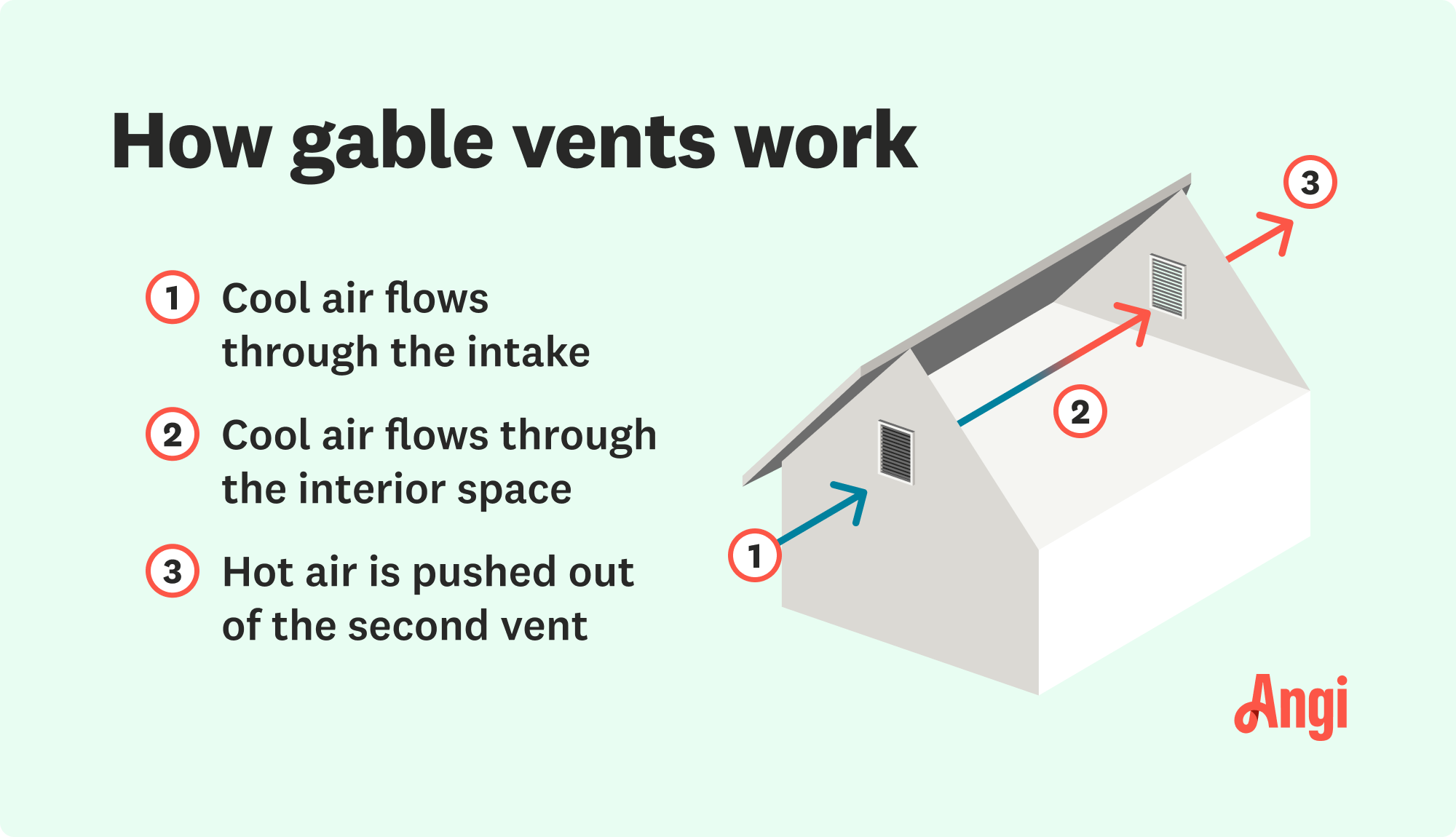
Dealing with a visibly damaged roof or leak? Learn about roof repair costs in Columbus to see how much you’ll need to budget for a permanent solution.
Try giving your attic some breathing room with gable vents


Gable vents are passive intake vents that encourage roof ventilation.
A well-ventilated attic prevents mold, keeps temperatures consistent, and prolongs the roof’s life span.
Gable vents can be used with soffit vents, not other ventilation systems.
A properly ventilated attic can extend the life of your roof, keep moisture, and better regulate your home's temperature.
An attic can grow hot and musty fast without ventilation, leading to mold and mildew. That heat and moisture can even warp shingles or distort the roof, triggering costly repairs. It’ll also keep your home from properly heating and cooling.
That’s where gable vents come in—but what exactly is a gable vent, and how does this simple feature help your home breathe easier? Learn how these popular passive vents work to keep things flowing properly.

Gable vents are passive vents located in the gable of a home or on homes with a gable roof. A gable is the tallest point of a wall near where two sides of the roof meet. Depending on wind direction and speed, gable vents can act as either intake or exhaust vents.
The gable vent is in the roof's gable and can be rectangular, circular, or triangular. Gable vents work in pairs; one must be placed opposing the other to work properly. In some cases, you’ll see gable vents installed with soffit vents.
A feature in older homes, gable vents can be highly ornate with detailing around them, or they may have a flat finish that blends into the home. In some older properties, they could be purely ornamental.

Gable vents work in a simple, passive way. Think of opening windows in a room. On a breezy day, when you open windows that oppose each other, you’ll notice a strong cross breeze flowing across the room. This cross breeze cools the room, keeping the air fresh and comfortable.
Gable vents work similarly, pulling cool air in through one vent and pushing hot air out the other. This continuous movement keeps moisture at bay and the attic at a consistent temperature.
A gable vent can help improve your home’s ventilation, but the system has benefits and drawbacks.
Aesthetically pleasing. If your home’s gables stand out, you can make the vents a functional design feature with specialty covers or louvers.
Cross ventilation. In a home with two gables across from each other, installing vents on opposite sides maximizes the ventilation and cross breeze and prevents moisture buildup.
Roof life span: A gable vent can help extend the life span of your roof by keeping mold and rot from developing.
Variety. Gable vents come in many styles, designs, and colors, making it easy to find ones that complement your home.
Saves money: They can help cut costs on your utility bills by keeping the temperature in your home consistent.
Can help prevent ice dams. The proper ventilation gable vents provide for an attic reduces the chance of ice dams forming since cold air is being circulated.
Can help prevent mold and mildew. The air flow provided by gable vents pulls moisture through the air so it doesn’t settle and lead to mold and mildew
Outdated. Alternative ventilation strategies, like soffit vents, may work more efficiently than gables vents.
Incompatible with complex roofs. If your attic has multiple beams or your roof features dormers, peaks, or valleys, a gable vent won’t be able to circulate air effectively.
Weather-driven. Gable vents work their best on days with a breeze. If you live in a calm-weather climate, the air can become stagnant and stale with gable vents.
Interference. Gable vents can’t be used with other venting or exhaust systems. For example, if you’re installing a ridge vent in a home with gable vents, you must seal up the existing gable vents to prevent disruption in the airflow patterns.
Gable vents are just one of the many types of roof vents found in homes. A ridge vent is another popular venting option.
There are a few differences to remember when considering gable vents versus ridge vents for your attic.
Type of roof. Gable vents work best with gable roofs, but ridge vents can work on several, but not all, types of roofs.
Efficiency. Ridge vents are larger and better positioned than gable vents, making them more efficient overall.
Other venting systems. Both gable and ridge vents work well with soffit intake vents, but a ridge vent must be used with some combination of another intake vent to work efficiently. On the other hand, gable vents will only work when they aren’t paired with other intake vents.
Gable vents may provide passive ventilation, but you’ll still need some maintenance as a homeowner to keep them in good shape.
For gable vents to work properly, make sure both vents are open. If one is closed, you won’t get the passive cross breeze. It may sound counterintuitive, but the vents should stay open year-round, even in the winter.
Additionally, check your gable vents seasonally to ensure debris isn’t clogging or blocking the airflow.
If you regularly maintain your vents but still find the air in the attic is stale, it’s time to reach out to a local attic fan installer or roofing professional in your area for troubleshooting.
Like your kitchen or bathroom, your roof needs ventilation to extend its life span and control temperatures. Proper roof ventilation helps reduce HVAC costs and prevents ice dams and moisture damage. A roof repair pro can assess your roof and make recommendations.
From average costs to expert advice, get all the answers you need to get your job done.

Dealing with a visibly damaged roof or leak? Learn about roof repair costs in Columbus to see how much you’ll need to budget for a permanent solution.

Learn about roof replacement costs in Columbus and what factors are at play to budget accurately and make sure you’re getting a fair price.

A metal roof can defend your home against Ohio’s varying weather conditions. Learn how much a metal roof costs in Columbus, OH.

A new or replacement attic fan will help your home stay well-ventilated and cool. If you're sold on the idea, learn how to install an attic fan in this guide.

If you need a new flat roof, learn about tar and gravel roof costs and what can affect your total to make sure you budget accurately.

Painting a metal roof helps it look great and last for decades. Use this guide to learn how to paint a metal roof, whether you DIY the job or hire a pro.